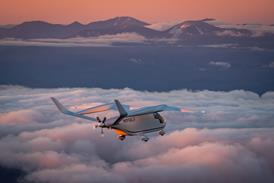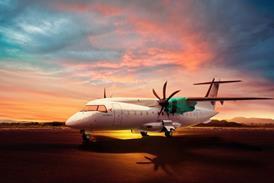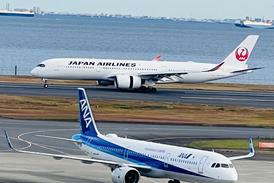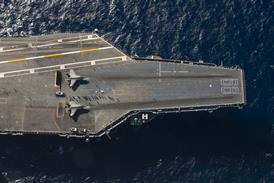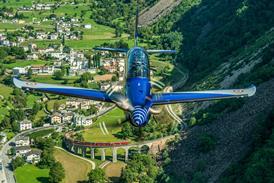Tim Furniss/LONDON
As James Weatherbee, commander of the US Space Shuttle Discovery, brought his orbiter close to the Russian Mir 1 space station on 6 February, he told the station's commander Alexander Viktorenko that he was "...bringing our nations closer together".
How close the nations become depends not just on the technical challenges facing the Shuttle missions sent to dock with the Mir. Perhaps more vitally, they depend on the funding of the two nations' space programmes in the lead-up to the proposed joint Alpha international space station after 1997.
NASA has been told that it must cut $5 billion from its budget over the next five years. Daniel Goldin, its administrator, says that NASA is being asked to do a lot more for far less and plans to "...revolutionise the agency", making it less of an operational and more of a research and development agency, and one considering the use of "less expensive vehicles".
The expensive Space Shuttle, the operation of which is already under intense pressure from budget cuts, could do without this pressure, especially when it is the major launcher for the Alpha programme and about to be used on the Mir docking flights.
Russia's space budget has also been reduced, to one-fifth of what it was five years ago. The Russian Government, is now cutting it by a further 40% to 1.2 billion roubles ($180 million, at market exchange rates), putting it on a par with India's programme. The Government says that the shortfall will have to be made up from commercial investment.
Yuri Koptev, director-general of the Russian Space Agency, says that his budget problems could "...curtail plans for launching manned space flights", and warns of 360,000 space-worker redundancies in 1995.
Veteran spacecraft and rocket designer Yuri Semenov, chief of the Energia company, says that 7,500 of his specialists have already been laid off, and a further 30,000 jobs are in jeopardy because of project cancellations.
Vladimir Ivanov, commander of Russia's military space forces, says that there are not enough boosters to support 75 planned launches in 1995. Many of the 49 (of a planned 102) civilian and military launches in 1994 were accommodated by a reserve of military rockets, which is now almost exhausted. Only seven new boosters were manufactured in 1994.
This financial climate is hardly the best in which to send the US Space Shuttle to the Russian Mir 1 space station in June, for the first of seven planned dockings and US/Russian joint operations over the next two years.
The dockings and operations will form the first phase towards establishing the Alpha international space station, construction of which is due to start in mid-1997, with the launch of a Russian Functional Energy Block (FGB).
The Alpha project is not yet safe. NASA has awarded the formal $5.63 billion contract to Boeing for the construction of the Alpha, but that does not necessarily mean that the project has finally cleared the US Congress, although the Republican party favours it more than does the Democratic party. The performance of the Atlantis in June will be an important factor.
PARTNERSHIP DOUBTS
Participation of other international partners - the European Space Agency (ESA), Canada and Japan - will depend on their continued goodwill, already stretched to the full by the design changes and budget arguments. The launches of their respective modules and equipment have moved into the 21st century.
The ESA, in particular, is being forced to reduce its space-station budget, and it is not inconceivable that it could withdraw. France and Germany have told it to cut its Columbus/Alpha budget by $2 billion, to about $2.5 billion, by 2000.
Cost considerations forced the USA and Russia to look seriously at joint operations in the first place. The catalyst was the collapse of the Soviet Union, which made co-operation a sensible option, both politically and financially.
Before the Mir 1 expires of old age, NASA and Russia have an opportunity to prepare for the Alpha operation. Two Russian cosmonauts have flown Space Shuttle missions. US astronaut Norman Thagard will be launched on a Russian Soyuz, on 14 March, to stay aboard the Mir 1 for about 80 days. Astronauts John Blaha and Shannon Lucid (the most-travelled US woman astronaut) are training for a second Mir 1 shift in 1996. One will fly. Two other astronauts will make later missions, extending long-duration flight experience for the USA.
The objectives of this Phase 1 co-operation, are to help each country learn to work with each other, to understand fully the technical issues, including space station construction and maintenance and operations, to give the USA long-duration flight experience; and to perform scientific experiments - which will take a back seat in the early stages.
NASA is paying Russia about $400 million to host these missions, and for the use of the two new Mir modules, the Spektr and Priroda. These modules are to be launched in May and October, much later than planned, and too late to be of much use to Thagard, whose US experimentation will be light.
The Space Shuttles will be used to ferry and return some Russian crews and the US astronauts - only Thagard will get a Soyuz ride. Although science is planned, the crews will find themselves spending a lot of time with logistics and servicing work
The high-profile flight of STS63 Discovery - which was not originally planned to include a Mir rendezvous, and was not part of the official Phase 1 co-operative programme - demonstrated how well US and Russian engineers can work together from their Houston and Kaliningrad control centres, overcoming the challenges of language and cultural and flight-protocol differences.
The STS63 launch in a 5min "window" was a demonstration of the similar routine launches which will have to be made during the Mir docking flights and for the Alpha space station assembly and servicing flights. The actual launch time for the Discovery was not computed until later in the countdown, based on latest Mir orbital data. The weather was good for the STS63, and it will be interesting to see to what extent flight rules may be waived in more marginal conditions.
VHF communications between the Shuttle and the Mir 1 were demonstrated on the STS63 mission. Communications from a distance of 40km (22nm) are planned eventually, and the Shuttle and Mir commanders will assume more in-flight responsibility and control.
The concern over the two leaking reaction-control thrusters aboard the Discovery and the possibility that the nitrogen-tetroxide propellant could damage the Mir's solar panels and optical instruments was an interesting test case for co-operation between the respective flight-control teams. After initially being against the planned close rendezvous, Russia allowed the Discovery (with its errant thrusters shut down) to come within 11.2m.
CO-OPERATION BONUS
Brewster Shaw, director of Space Shuttle operations and a former Shuttle astronaut, says that the thruster debate provided an unexpected opportunity for the two parties to "...figure out how we are going to deal with each other, how we are going to operate together, and how we are going to overcome unexpected things that arise in the future. It was a special plus, I think, to be able to do even more negotiation and more co-operation with our Russian partners on this flight than we anticipated".
The piloting of Weatherbee, bringing the Shuttle in towards the Mir, provided vital data and experience to enable the STS71/Atlantis commander, Robert "Hoot" Gibson, to go the last 11.2m in June, and very delicately dock with the Mir's Kristall module port, at a speed of just 0.1ft/s (0.03m/s). The Soyuz docks with the Mir at a speed of 0.4ft/s. Photographs and observations taken during the Discovery approach and subsequent fly-around of the entire station, from a distance of 120m, will be invaluable.
The docking of two such large vehicles has never been accomplished before. It is acknowledged that it is going to be dangerous. Gibson will have just 4min to complete the docking over a Russian tracking station in central Asia and will have to use a camera on the Rockwell/NPO Energia-built airlock and androgynous docking system to have a clear view of the Mir's port.
The ten-person Shuttle-Mir crew - Thagard and two Russians (Vladimir Dezhurov and Gennadi Strekalov) plus two Russians brought up in the Atlantis (Anatoli Solovyov and Nikolai Budarin), together with the Shuttle's own crew (Gibson, Charles Precourt, Ellen Baker, Greg Harbaugh and Thagard's back-up Bonnie Dunbar) will conduct joint work and have the use of a Spacelab laboratory in the Atlantis payload bay.
Solovyov and Budarin will be left aboard the Mir and Thagard, while Dezhurov and Strekalov will be brought home as part of an eight-person crew. The only other flight to carry eight was the STS61A/Challenger/ Spacelab D mission in 1985.
The crew for the STS74/Atlantis mission - to dock with the Mir 1 in October - has been selected. The commanders for the STS76 and 81, scheduled for March and December 1996 respectively, Kevin Chilton and William Readdy, have been assigned. Activities on these later flights will be more complex.
The STS74/SMM 2, under the command of Kenneth Cameron, will carry some US solar arrays to be integrated with those on the Mir 1, to improve electrical generation. Eighty-four of the modules each containing 80 solar cells, will be integrated as 42 hinged-pairs.
Space walks are planned for later Shuttle missions. The STS76/SMM 3 has provisions for two astronauts to make walks to mount experiments on the exterior of the Mir 1, while the SMM 5 will include a space walk, possibly by one Russian and one US astronaut, both wearing Russian suits. Scheduled for the SMM7 in May 1997 is the world's first four-person space walk (two Russians and two Americans) to deploy a solar-dynamics module on to the outside of the Mir 1. This will be the most realistic rehearsal of space-station assembly ever to be undertaken.
Once the FGB has started the Alpha programme, a vacant Mir 1 will be kept alive for another year to 1998, to enable evaluation of the new solar-power system.
Source: Flight International

